Monday, June 04. 2012
Invasion of the Tiny, Linux-Powered PCs
Via LinuxInsider
-----
Bigger may be better if you're from Texas, but it's becoming increasingly clear to the rest of us that it really is a small world after all.
Case in point? None other than what one might reasonably call the invasion of tiny Linux PCs going on all around us.
We've got the Raspberry Pi, we've got the Cotton Candy. Add to those the Mele A1000, the VIA APC, the MK802 and more, and it's becoming increasingly difficult not to compute like a Lilliputian.
Where's it all going? That's what Linux bloggers have been pondering in recent days. Down at the seedy Broken Windows Lounge the other night, Linux Girl got an earful.
It's 'Fantastic'
"Linux has been heading towards one place for many years now: complete and total world domination!" quipped Thoughts on Technology blogger and Bodhi Linux lead developer Jeff Hoogland.
"All joking aside, these new devices simply further showcase Linux's unmatched ability to be flexible across an array of different devices of all sizes and power," Hoogland added.
"Having a slew of devices that are powerful enough for users to browse the web -- which, let's be honest, is all a good deal of people do these days -- for under 100 USD is fantastic," he concluded.
'It Only Gets More Exciting'
Similarly, "I believe that the medley of tiny Linux PCs we're seeing hitting the market lately is the true sign of the Post PC Era," suggested Google+ blogger Linux Rants.
"The smartphone started it, but the Post PC Era will begin in earnest when the functionality that we currently see in the home computer is replaced by numerous small appliance-type devices," Linux Rants explained. "These tiny Linux PCs are the harbinger of those appliances -- small, low-cost, programmable devices that can be made into virtually anything the owner desires."
Other devices we're already seeing include "the oven that you can
turn on with a text message, the espresso machine that you can control
with a text message, home security ![]() systems and cars that can be controlled from your smartphone," he
added. "This is where the Post PC Era begins, and it only gets more
exciting from here."
systems and cars that can be controlled from your smartphone," he
added. "This is where the Post PC Era begins, and it only gets more
exciting from here."
'There Is No Reason Not to Do It'
This is "definitely the wave of the future," agreed Google+ blogger Kevin O'Brien.
"Devices of all kinds are getting smaller and smaller, while simultaneously increasing their power," O'Brien explained. "Exponential growth does that over time.
"My phone in my pocket right now has more computing power than the rockets that went to the moon," he added. "And if you look ahead, a few more turns of exponential growth means we'll have the equivalent of a full desktop computer the size of an SD card within a few years."
At that point, "everything starts to be computerized, because adding a little intelligence is so cheap there is no reason not to do it," O'Brien concluded.
'We're Approaching That Future'
Indeed, "many including myself have long been harping on the fact that today's computers are orders of magnitude faster than early systems on which we ran graphic interfaces and got work done, and yet are dismissed as toys," Hyperlogos blogger Martin Espinoza told Linux Girl.
"A friend suggested to me once that eventually microwave ovens would contain little Unix servers 'on a chip' because that would be basically all you could get, because it would actually be cheaperto use such a system when given the cost of developing an alternative," he said. "Seeing the cost of these new products it looks to me like we're approaching that future rapidly.
"There has always been demand for low-cost computers, and the massive proliferation of low-cost, low-power cores has pushed their price down to the point where we can finally have them," Espinoza concluded.
"Even adjusted for inflation," he said, "many of these computers are an order of magnitude cheaper than the cheapest useful home computers from the time when personal computing began to gain popularity, and yet they are certainly powerful enough to serve many roles including many people's main or even only 'computer.'"
'It Gives Me Hope'
Consultant and Slashdot blogger Gerhard Mack was similarly enthusiastic.
"I love it," Mack told Linux Girl.
"When I was a child, my parents brought home all sorts of fun things to tinker with, and I learned while doing it," he explained. "But these last few years it seems like the learning electronics and their equivalents have disappeared into a mass of products that are only for what the manufacturer designed them for and nothing else.
"I am loving the return of my ability to tinker," Mack concluded. "It gives me hope that there can be a next generation of kids who can love the enjoyment of simply creating things."
'They Look a Bit Expensive'
Not everyone was thrilled, however.
"Okay, I am not all that excited about the invasion of the tiny PC," admitted Roberto Lim, a lawyer and blogger on Mobile Raptor.
"With 7-inch Android tablets with capacitive displays, running Android 4.0 and with access to Google (Nasdaq: GOOG) Play's Android app market, 8 GB or storage expandable via a Micro SD card, 1080p video playback, a USB port and HDMI out and 3000 to 4000 mAh batteries starting at US$90, it is a bit hard to get excited about these tiny PCs," Lim explained.
"Despite the low prices of the tiny PCs, they all look a bit expensive when compared to what is already in the market," he opined.
'These Devices Have a Niche'
The category really isn't even all that new, Slashdot blogger hairyfeet opined.
"There have been mini ARM-based Linux boxes for several years now," he explained. "From portable media players to routers to set-top boxes, there are a ton of little bitty boxes running embedded Linux."
It's not even quite right to call such devices PCs "because PC has an already well-defined meaning: it was originally 'IBM PC compatible,'" hairyfeet added. "Even if you give them the benefit of the doubt, PCs have always been general use computers, and these things are FAR from general use."
Rather, "they are designed with a very specific and narrow job in mind," he said. "Trying to use them as general computers would just be painful."
So, "in the end these devices have a niche, just as routers and beagleboards and the pi does, but that niche is NOT general purpose in any way, shape, or form," hairyfeet concluded.
'Opportunities for Specialists'
Chris Travers, a Slashdot blogger who works on the Ledger SMB project, considered the question through the lens of evolutionary ecology.
"In any ecological system an expanding niche allows for differentiation, and a contracting niche requires specialization," Travers pointed out. 'So, for example, if a species of moth undergoes a population explosion, predators of that moth will often specialize and be more picky as to what prey they go after."
The same thing happens with markets, Travers suggested.
"When a market expands, it provides opportunities for specialists, but when it contracts, only the generalists can survive," he told Linux Girl.
'Niche Environments'
The tiny new devices are "replacements for desktop and laptop systems in niche environments," Travers opined.
"In many environments these may be far more capable than traditional systems," he added.
The bottom line, though, "is that the Linux market is growing at a healthy rate," Travers concluded.
'The Right Way to Do IT'
"Moore's Law allows the world to do more with less hardware and so does FLOSS," blogger Robert Pogson told Linux Girl. "It's the right way to do IT rather than paying a bunch for the privilege of running the hardware we own."
Last year was a turning point, Pogson added.
"More people bought small, cheap computers running Linux than that other OS, and the world saw that things were fine without Wintel," he explained. "2012 will bring more of the same." By the end of this year, in fact, "the use of GNU/Linux on small cheap computers doing what we used to do with huge hair-drying Wintel PCs will be mainstream in many places on Earth," Pogson predicted. "In 2012 we will see a major decline in the number of PCs running that other OS. We will see major shelf-space given to Linux PCs at retail."
Monday, May 14. 2012
Facebook's New App Center Promises Quality Over Quantity
Via ReadWrite
----- 
Last September, during the f8 Developers’ Conference, Facebook CTO Bret Taylor said that the company had no plans for a “central app repository” – an app store. Today, Facebook is changing its tune. The social giant has announced App Center, a section of Facebook dedicated to discovering and deploying high-quality apps on the company’s platform. The App Center will push apps to iPhone, Android and the mobile Web, giving Facebook its first true store for mobile app discovery.
The departure from Facebook’s previous company line comes as the social platform ramps up its mobile offerings to make money from its hundreds of millions of mobile users. This is not your father's app store, though.
Let's start with the requirements. Facebook has announced a strict set of style and quality guidelines to get apps placed in App Center. Apps that are considered high-quality, as decided by Facebook’s Insights analytics platform, will get prominent placement. Quality is determined by user ratings and app engagement. Apps that receive poor ratings or do not meet Facebook’s quality guidelines won't be listed.
Whether or not an app is a potential Facebook App Center candidate hinges on several factors. It must
• have a canvas page (a page that sets the app's permissions on Facebook’s platform)
• be built for iOS, Android or the mobile Web
• use a Facebook Login or be a website that uses a Facebook Login.
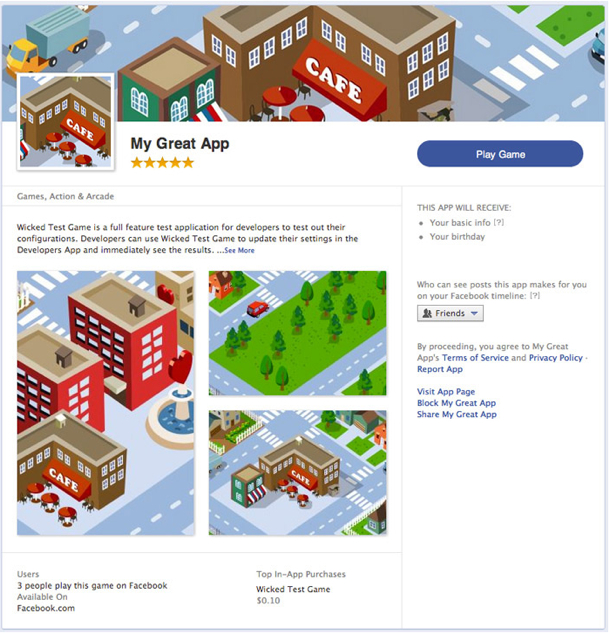
Facebook is in a tricky spot with App Center. It will house not only apps that are specifically run through its platform but also iOS and Android apps. Thus it needs to achieve a balance between competition and cooperation with some of the most powerful forces in the tech universe. If an app in App Center requires a download, the download link on the app’s detail page will bring the user to the appropriate app repository, either Apple's App Store or Android’s Google Play.
One of the more interesting parts of App Center is that Facebook will allow paid apps. This is a huge move for Facebook as it provides a boost to its Credits payment service. One of the benefits of having a store is that whoever controls the store also controls transactions arising from the items in it, whether payments per download or in-app purchases. This will go a long way towards Facebook’s goal of monetizing its mobile presence without relying on advertising.
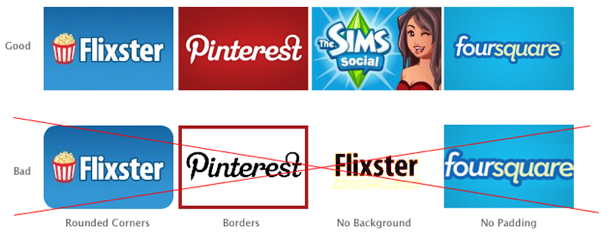
Facebook App Center Icon Guidelines
Developers interested in publishing apps to Facebook’s App Center should take a look at both the guidelines and the tutorial that outlines how to upload the appropriate icons, how to request permissions, how to use Single Sign On (SSO, a requirement for App Center) and the app detail page.
This is a good move for Facebook. It will give the company several
avenues to start making money off of mobile but also strengthen its
position as one of the backbones of the Web. For instance, App Center is
both separate from iOS and Android but also a part of it. Through App
Center, Facebook can direct traffic to its apps, monitor who and how
users are downloading applications and keep itself at the center of the
user experience.
Friday, May 11. 2012
The Cloud Storage Showdown – Dropbox, Google Drive, SkyDrive & More
Via makeuseof
-----
The cloud storage scene has heated up recently, with a long-awaited entry by Google and a revamped SkyDrive from Microsoft. Dropbox has gone unchallenged by the major players for a long time, but that’s changed – both Google and Microsoft are now challenging Dropbox on its own turf, and all three services have their own compelling features. One thing’s for sure – Dropbox is no longer the one-size-fits-all solution.
These three aren’t the only cloud storage services – the cloud storage arena is full of services with different features and priorities, including privacy-protecting encryption and the ability to synchronize any folder on your system.
Dropbox
Dropbox introduced cloud storage to the masses, with its simple approach to cloud storage and synchronization – a single magic folder that follows you everywhere. Dropbox deserves credit for being a pioneer in this space and the new Google Drive and SkyDrive both build on the foundation that Dropbox laid.
Dropbox doesn’t have strong integration with any ecosystems – which can be a good thing, as it is an ecosystem-agnostic approach that isn’t tied to Google, Microsoft, Apple, or any other company’s platform.

Dropbox today is a compelling and mature offering supporting a wide variety of platforms. Dropbox offers less free storage than the other services (unless you get involved in their referral scheme) and its prices are significantly higher than those of competing services – for example, an extra 100GB is four times more expensive with Dropbox compared to Google Drive.
- Supported Platforms: Windows, Mac, Linux, Android, iOS, Blackberry, Web.
- Free Storage: 2 GB (up to 16 GB with referrals).
- Price for Additional Storage: 50 GB for $10/month, 100 GB for $20/month.
- File Size Limit: Unlimited.
- Standout Features: the Public folder is an easy way to share files. Other services allow you to share files, but it isn’t quite as easy. You can sync files from other computers running Dropbox over the local network, speeding up transfers and taking a load off your Internet connection.

Google Drive
Google Drive is the evolution of Google Docs, which already allowed you to upload any file – Google Drive bumps the storage space up from 1 GB to 5 GB, offers desktop sync clients, and provides a new web interface and APIs for web app developers.
Google Drive is a serious entry from Google, not just an afterthought like the upload-any-file option was in Google Docs.

Its integration with third-party web apps – you can install apps and associate them with file types in Google Drive – shows Google’s vision of Google Drive being a web-based hard drive that eventually replaces the need for desktop sync clients entirely.
- Supported Platforms: Windows, Mac, Android, Web, iOS (coming soon), Linux (coming soon).
- Free Storage: 5 GB.
- Price for Additional Storage: 25 GB for $2.49/month, 100 GB for $4.99/month.
- File Size Limit: 10 GB.
- Standout Features: Deep search with automatic OCR and image recognition, web interface that can launch files directly in third-party web apps.

You can actually purchase up to 16 TB of storage space with Google Drive – for $800/month!
SkyDrive
Microsoft released a revamped SkyDrive the day before Google Drive launched, but Google Drive stole its thunder. Nevertheless, SkyDrive is now a compelling product, particularly for people into Microsoft’s ecosystem of Office web apps, Windows Phone, and Windows 8, where it’s built into Metro by default.
Like Google with Google Drive, Microsoft’s new SkyDrive product imitates the magic folder pioneered by Dropbox.

Microsoft offers the most free storage space at 7 GB – although this is down from the original 25 GB. Microsoft also offers good prices for additional storage.
- Supported Platforms: Windows, Mac, Windows Phone, iOS, Web.
- Free Storage: 7 GB.
- Price for Additional Storage: 20 GB for $10/year, 50 GB for $25/year, 100 GB for $50/year
- File Size Limit: 2 GB
- Standout Features: Ability to fetch unsynced files from outside the synced folders on connected PCs, if they’ve been left on.

Other Services
SugarSync is a popular alternative to Dropbox. It offers a free 5 GB of storage and it lets you choose the folders you want to synchronize – a feature missing in the above services, although you can use some tricks to synchronize other folders. SugarSync also has clients for mobile platforms that don’t get a lot of love, including Symbian, Windows Mobile, and Blackberry (Dropbox also has a Blackberry client).

Amazon also offers their own cloud storage service, known as Amazon Cloud Drive. There’s one big problem, though – there’s no official desktop sync client. Expect Amazon to launch their own desktop sync program if they’re serious about competing in this space. If you really want to use Amazon Cloud Drive, you can use a third-party application to access it from your desktop.

Box is popular, but its 25 MB file size limit is extremely low. It also offers no desktop sync client (except for businesses). While Box may be a good fit for the enterprise, it can’t stand toe-to-toe with the other services here for consumer cloud storage and syncing.
If you’re worried about the privacy of your data, you can use an encrypted service, such as SpiderOak or Wuala, instead. Or, if you prefer one of these services, use an app like BoxCryptor to encrypt files and store them on any cloud storage service.
Thursday, May 10. 2012
Wolfenstein on the Web
Via Christian Babski
-----

Remember your first time being sick in front of a screen!
Wednesday, May 02. 2012
The state of responsive advertising: the publishers' perspective
Via Christian Babski
-----

The Internet is about (if it is not already a terminated task!) to become a pretty classical media. Country's boundaries were raised up on the net, making unavailable some contents depending on the world region you are browsing from (pretty weird, middle-age based concept of what the Internet must be)... We are now heavily targeted by many advertisements all around contents we are trying to access from the Web, pop-up blockers are now totally useless as advertisements took fairly advantage of HTML evolution. It is more and more difficult to ignore these advertisements, and even by closing them, one already produces/gives an information to Big Brother. There is less and less ways to escape, and by reading the following article, it looks like we are not supposed to escape... by the way.
Responsive Advertising article
The opportunity to set up an alternative network (satellite based?) may be the only way to get a new [commercially virgin] web... Let's call it The Veb... underlying the need of a step back from where we are nowadays.
Tuesday, May 01. 2012
HomeOS: Enabling smarter homes for everyone
Via Christian Babski
-----

It looks like that Microsoft is about to propose the access to an operating system design to control your... home. The prototype seems to be accessible freely for non-commercial use.
Here is the abstract and a direct link to the research program's web page:
It is no secret that homes are ever-increasing hotbeds of new technology such as set-top boxes, game consoles, wireless routers, home automation devices, tablets, smart phones, and security cameras. This innovation is breeding heterogeneity and complexity that frustrates even technically-savvy users’ attempts to improve day-to-day life by implementing functionality that uses these devices in combination. For instance, it is impossible for most users to view video captured by their security camera on their smartphone when they are not at home. Heterogeneity across devices and across homes also makes it difficult to develop applications that solve these problems in a way that work across a range of homes.
To simplify the management of technology and to simplify the development of applications in the home, we are developing an "operating system" for the home. HomeOS provides a centralized, holistic control of devices in the home. It provides to users intuitive controls to manage their devices. It provided to developers high-level abstractions to orchestrate the devices in the home. HomeOS is coupled with a HomeStore through which users can easily add obtain applications that are compatible with devices in their homes and obtain any additional devices that are needed to enable desired applications.
Wednesday, April 25. 2012
PlayThru offers playful captcha alternative
Via übergizmo
-----
Don’t you just hate it when you often need to solve a captcha whenever you want to log in to select websites? You know, those irritating slanted and jumbled group of letters and numbers, where sometimes, you cannot even tell whether it is the letter ‘o’ or the number ’0?, or if the particular letter is in the uppercase or not. Captchas have been employed for some years already in order to verify that the person behind the computer is made out of flesh and bone, and is not an automated robot or program of any kind. Detroit-based tech company Are You A Human (interesting name) has come up with a different way of verifying the authenticity of a user – not through captchas, but rather, the idea of a simple game known as PlayThru.

PlayThru claims to prevent bots from spamming sites, as the game can only be completed by an actual human being. Definitely sounds far more fun in theory to “solve”, and if your less than informed boss walks by your desk to see you play the latest game, just tell him or her that you are solving a captcha replacement before you are able to start work.
To get a better idea on how PlayThru works, here is an example of just one of the games. You will be presented with your fair share of items, including a shoe, a football jersey, an olive and a piece of bacon, where all of them will float right beside a pizza. Should you drag the right ingredients over the pizza, then you would have “won”, and so far, I do not think that anyone would like a topping of shoes on their pizza.
Thursday, April 12. 2012
Paranoid Shelter - [Implementation Code]
By Computed·By
-----
Paranoid Shelter is a recent installation / architectural device that fabric | ch finalized later in 2011 after a 6 months residency at the EPFL-ECAL Lab in Renens (Switzerland). It was realized with the support of Pro Helvetia, the OFC, the City of Lausanne and the State of Vaud. It was initiated and first presented as sketches back in 2008 (!), in the context of a colloquium about surveillance at the Palais de Tokyo in Paris.
Being created in the context of a theatrical collaboration with french writer and essayist Eric Sadin around his books about contemporary surveillance (Surveillance globale and Globale paranoïa --both published back in 2009--), Paranoid Shelter revisits the old figure/myth of the architectural shelter, articulated by the use of surveillance technologies as building blocks.
Additionnal information on the overall project can be found through the two following links:
Paranoid Shelter - (Globale Surveillance)
(Paranoid Shelter) - Globale Surveillance

A compressed preview and short of the play by NOhista.
-----
On the first technical drawings and sketches of the Paranoid Shelter project, the entire system was just looking like a (big) mess of wires, sensors and video cameras, all concentrated on a pretty tiny space where humans will have difficulties to move in. The entire space is consciously organised around tracking methods/systems, the space being delimited by 3 [augmented] posts which host a set of sensors, video cameras and microphones. It includes networked [power over ethernet] video cameras, microphones and a set of wireless ambient sensors (giving the ability of measuring temperature, O2 and CO2 gaz concentration, current atmospheric pressure, light, etc...).


Based on a real-time analysis of major sensors hardware, the system is able to control DMX lights, a set of two displays (one LCD screen and one projector) and to produce sound through a dynamically generated text to speech process.
All programs were developed using openFrameworks enhanced by a set of dedicated in-house C++ libraries in order to be able to capture networked camera video flow, control any DMX compatible piece of hardware and collect wireless Libelum sensor's data. Sound analysis programs, LCD display program and the main program are all connected to each other via a local network. The main program is in charge of collecting other program's data, performing the global analysis of the system's activity, recording system's raw information to a database and controlling system's [re]actions (lights, display).
The overall system can act in an [autonomous] way by controlling the entire installation behavior while it can also be remotely controlled when used on stage, in the context of a theater play.

Collecting all sensor's flows is one of the basic task. Cameras are used to track movements, microphones measure sound activity and sensors collect a set of ambient parameters. Even if data capture consists in some basic network based tasks, it is easily raised to upper complexity level when each data collection should occur simultaneously, in real-time, [without,with] a [limited,acceptable] delay. Major raw data analysis have to occur directly after data acquisition in order to minimize the time-shift in the system's space awareness. This first level of data analysis brings out mainly frequencies information, quantity of activity and 2D location tracking (from the point of view of each camera). Every single piece of raw information is systematically recorded in a dedicated database : it reduces system's memory footprint (by keeping it almost constant) without loosing any activity information. From time to time the system can access these recorded information in its post-analysis process, when required, mainly to add a time-scale dimension on the global activity that occurred in the monitored space. Time isolated information can be interpreted in a rough and basic way, while time composition of the same information or a set of information may bring additional meanings by verifying information consistency over time (of course, it could be in a negative or a positive way, by confirming or refuting a first level deduced activity information). Another level of analysis can be reached by taking in account the spacial distribution of sensors in the overall installation. The system is then able to compute 3D information getting an awareness of activities within the space it is monitoring. It generates a second level of data analysis, spatialised, that will increase the global understanding of captured data by the system.
Recorded activities are made available to the [audience,visitors] through a wifi access point. Networked cameras can be accessed in real time, giving the ability to humans to see some of the system's [inputs]. Thus, network activity is also monitored as another sign of human presence, the system can then [detect] activity elsewhere than in its dedicated space.
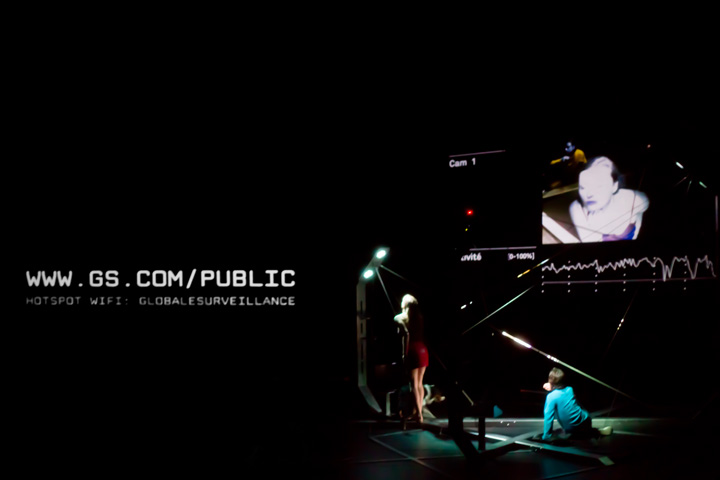
Whatever how numerous are collected data, the system faces a real problem when it comes to the interpretation of these data while not having benefit of a human brain. Events that are quite obvious to humans, do not mean anything to computers and softwares. In order to avoid the use of some artificial neural networks simulation (which may still be a good option to explore), I have decided to compute a limited set of parameters, all based on previously analysed data, only computed lately when the system may decide to react to perceived activities. It defines a kind of global [mood] of the system, based on which it will [decide] whether to be aggressive (from a human point of view) by making the global tracking activity [noticeable] by humans evolving in the installation's space, or by focusing tracking sensors on a given area or by trying to enhance some sensor's information analysis, whether to settle in a kind of silent mode.
Moreover, the evolution of these parameters are also studied in time, making the [mood] evolving in a human way, increasing and decreasing [analogically]. System's [mood] may be wrong or [unjustified,weird] from a human point of view, but that's where [multi-dimensional] software becomes interesting. Beyond a certain complexity, by adding computation layers on top of each over, having written every single line of code does not allow the programmer to predict precisely what next system's [re]action will be.
We did reach here monitoring system limitations which is obviously [interpretation,comprehension]. As long as automatic system can not correctly [understand] data, humans will need to be in the loop, making all these monitoring systems quite useless [as expert system], except for producing an enormous quantity of data that still need to be post-analysed by a human brain. As the system is producing an important set of heteregeneous data, a set of rules may suggest to the system some sort of data correlation. These rules should not be too [tights,precises] in order to avoid producing obvious system's interpretation, while keeping them slightly [out of focus] may allow [smart,astonishing] conclusion being produced. So there's rooms here for additional implementation of the data analysis processes that can still completely change the way the entire installation [can,may] behave.
Friday, March 30. 2012
Fake ID holders beware: facial recognition service Face.com can now detect your age
Via VB
-----
Facial-recognition platform Face.com could foil the plans of all those under-age kids looking to score some booze. Fake IDs might not fool anyone for much longer, because Face.com claims its new application programming interface (API) can be used to detect a person’s age by scanning a photo.
With its facial recognition system, Face.com has built two Facebook apps that can scan photos and tag them for you. The company also offers an API for developers to use its facial recognition technology in the apps they build.
Its latest update to the API can scan a photo and supposedly determine a person’s minimum age, maximum age, and estimated age. It might not be spot-on accurate, but it could get close enough to determine your age group.
“Instead of trying to define what makes a person young or old, we provide our algorithms with a ton of data and the system can reverse engineer what makes someone young or old,” Face.com chief executive Gil Hirsch told VentureBeat in an interview. ”We use the general structure of a face to determine age. As humans, our features are either heighten or soften depending on the age. Kids have round, soft faces and as we age, we have elongated faces.”
The algorithms also take wrinkles, facial smoothness, and other telling age signs into account to place each scanned face into a general age group. The accuracy, Hirsch told me, is determined by how old a person looks, not necessarily how old they actually are. The API also provides a confidence level on how well it could determine the age, based on image quality and how the person looks in photo, i.e. if they are turned to one side or are making a strange face.
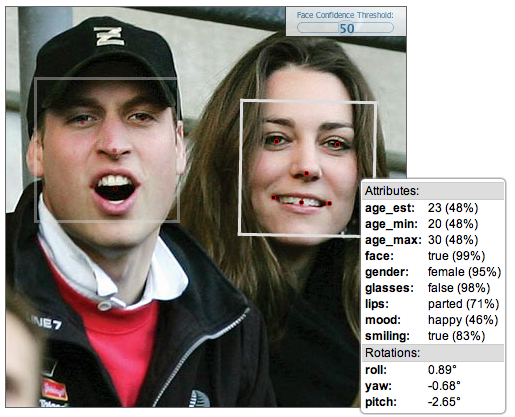
“Adults are much harder to figure out [their age], especially celebrities. On average, humans are much better at detecting ages than machines,” said Hirsch.
The hope is to build the technology into apps that restrict or tailor content based on age. For example the API could be built into a Netflix app, scan a child’s face when they open the app, determine they’re too young to watch The Hangover, and block it. Or — and this is where the tech could get futuristic and creepy — a display with a camera could scan someone’s face when they walk into a store and deliver ads based on their age.
In addition to the age-detection feature, Face.com says it has updated its API with 30 percent better facial recognition accuracy and new recognition algorithms. The updates were announced Thursday and the API is available for any developer to use.
One developer has already used the API to build app called Age Meter, which is available in the Apple App Store. On its iTunes page, the entertainment-purposes-only app shows pictures of Justin Bieber and Barack Obama with approximate ages above their photos.
Other companies in this space include Cognitec, with its FaceVACS software development kit, and Bayometric, which offers FaceIt Face Recognition. Google has also developed facial-recognition technology for Android 4.0 and Apple applied for a facial recognition patent last year.
The technology behind scanning someone’s picture, or even their face, to figure out their age still needs to be developed for complete accuracy. But, the day when bouncers and liquor store cashiers can use an app to scan a fake ID’s holder’s face, determine that they are younger than the legal drinking age, and refuse to sell them wine coolers may not be too far off.
Thursday, March 15. 2012
MIT App Inventor open beta preview debuts
Via Slash Gear
-----
Back in January, we talked a bit about the new MIT App Inventor software aimed at helping people that aren’t developers to build their own apps. MIT promised to have App Inventor available in Q1 of 2012. The first quarter is quickly winding down, and it was looking a bit like MIT might not make its self-imposed deadline.
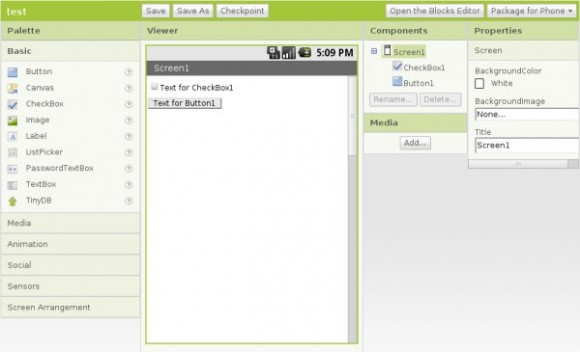
MIT has now announced that it is meeting the goal of making App Inventor available as a public service in Q1. The App Inventor software has been in closed testing the last two months with 5000 users. The App Inventor software is now available in open beta to anyone who has a Google ID to login, such as a Gmail account.
MIT points out that the software is suitable for any use, but users need to be aware that this will be the first time the system is loaded so heavily, which could cause issues. MIT suggests that users make backups of important apps as the service ramps up with more and more users, in case there are issues. MIT also notes that it is still working on fixing remaining glitches and other errors.
We owe a large debt to our testers of the past few months; it’s been their feedback that’s given us the confidence for today’s announcement. And we’re tremendously grateful to the folks who have been running their own system with the MIT JAR files. Their experiences have been an invaluable source of information, and their work has been critical in keeping App Inventor alive while the MIT service was not yet available. We also want to acknowledge the growing group of developers who are starting to explore the App Inventor source code. They are the seeds of an open source community that we hope will take App Inventor beyond anything we could do by ourselves at MIT. And our extreme gratitude and admiration goes to the Google App Inventor team who, even while their project transitions out of Google, have continued to share their expertise and the fruit of their hard work of the past three years.
Quicksearch
Popular Entries
- The great Ars Android interface shootout (130545)
- Norton cyber crime study offers striking revenue loss statistics (100306)
- MeCam $49 flying camera concept follows you around, streams video to your phone (99483)
- The PC inside your phone: A guide to the system-on-a-chip (56805)
- Norton cyber crime study offers striking revenue loss statistics (56535)
Categories
Show tagged entries
Syndicate This Blog
Calendar
|
|
November '25 | |||||
| Mon | Tue | Wed | Thu | Fri | Sat | Sun |
| 1 | 2 | |||||
| 3 | 4 | 5 | 6 | 7 | 8 | 9 |
| 10 | 11 | 12 | 13 | 14 | 15 | 16 |
| 17 | 18 | 19 | 20 | 21 | 22 | 23 |
| 24 | 25 | 26 | 27 | 28 | 29 | 30 |
